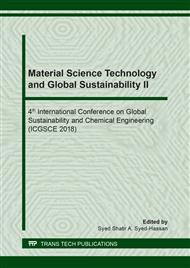[1]
Uemura Y, Omar W.N., T.Tsutsui, S.Yusup. (2011). Torrefaction of oil palm wastes. Fuel 90, 2585-2591.
DOI: 10.1016/j.fuel.2011.03.021
Google Scholar
[2]
Arias, B., Pevida, C., Fermoso, J., Plaza, M., Rubiera, F., Pis, J. (2008). Influence of torrefaction on the grindability and reactivity of woody biomass. Fuel Processing Technology, 89(2), 169-175.
DOI: 10.1016/j.fuproc.2007.09.002
Google Scholar
[3]
Chen, W., Kuo, P. (2010). A study on torrefaction of various biomass materials and its impact on lignocellulosic structure simulated by a thermogravimetry. Energy, 35(6), 2580-2586.
DOI: 10.1016/j.energy.2010.02.054
Google Scholar
[4]
Bridgeman, T., Jones, J., Shield, I., Williams, P. (2008). Torrefaction of reed canary grass, wheat straw and willow to enhance solid fuel qualities and combustion properties. Fuel, 87(6), 844-856.
DOI: 10.1016/j.fuel.2007.05.041
Google Scholar
[5]
Poudal, Jeeban, Tae-In Ohm. (2015). A study on torrefaction of food waste. Fuel, 275-281.
Google Scholar
[6]
Chen, H., Jiang, W., Yang, Y., Yang, Y., Man, X. (2017). State of the art on food waste research: A bibliometrics study from 1997 to 2014. Journal of Cleaner Production, 140, 840-846.
DOI: 10.1016/j.jclepro.2015.11.085
Google Scholar
[7]
FAO (2015). (2017, November 15). Food Loss and Food Waste. Retrieved from Food and Agriculture Organization of the United Nations: http://www.fao.org/food-loss-and-food-waste/en.
DOI: 10.19103/as.2019.0053.01
Google Scholar
[8]
Bong, C. P., Ho, W. S., Hashim, H., Lim, J. S., Ho, C. S., Tan, W. S., Lee, C. T. (2017). Review on the renewable energy and solid waste management oilicies towards biogas development in Malaysia. Renewable ad sustainable energy review, 988-998.
DOI: 10.1016/j.rser.2016.12.004
Google Scholar
[9]
Suseno, S. H. (2013). Determination of extraction temperature and period of fish oil from Tilapia by using wet rendering. KnE Life Science, 125-135.
DOI: 10.18502/kls.v1i0.96
Google Scholar
[10]
Suseno, S.H, Nurjanah, Yoshiara, Saraswati. (2015). Determination of extraction temperature and period of fish oil from Tilapia (Oreochromis Niloticus) by product using wet rendering method. KnE Life Science, 126-135.
DOI: 10.18502/kls.v1i0.96
Google Scholar
[11]
ASTM, A. S. (2008). Standard Test Method for Instrumental Determination of Carbon, Hydrogen and Nitrogen in Laboratory Samples of Coal. ASTM D5373-08.
Google Scholar
[12]
Friedl, A., Padouvas, E., Rotter, H., Varmuza, K. (2005). Prediction of heating values of biomass fuel from elemental composition. Analytica Chimica Acta, 544(1-2), 191-198.
DOI: 10.1016/j.aca.2005.01.041
Google Scholar
[13]
Antony, D., Murugavelh, S. (2016). Anaerobic co-digestion of kitchen waste and wastewater sludge: biogas-based power generation. Biofuels, 1-6.
DOI: 10.1080/17597269.2016.1234195
Google Scholar
[14]
Channiwala, S., Parikh, P. (2002). A unified correlation for estimating HHV of solid, liquid and gaseous fuels. Fuel, 81(8), 1051-1063.
DOI: 10.1016/s0016-2361(01)00131-4
Google Scholar
[15]
Tillman, D. A. (1991). Characteristics of Biomass Fuel. Combustion of Solid Fuels & Wastes, 65-119.
DOI: 10.1016/b978-0-08-057112-6.50006-9
Google Scholar
[16]
Balat, M., Balat, M., Kırtay, E., Balat, H. (2009). Main routes for the thermo-conversion of biomass into fuels and chemicals. Part 2: Gasification systems. Energy Conversion and Management, 3158-3168.
DOI: 10.1016/j.enconman.2009.08.013
Google Scholar
[17]
Prins, M. J., Ptasinski, K. J., Janssen, F. J. (2006). Torrefaction of wood. Journal of Analytical and Applied Pyrolysis, 35-40.
DOI: 10.1016/j.jaap.2006.01.001
Google Scholar
[18]
Sadaka, S., Sharara, M., Ashworth, A., Keyser, P., Allen, F., Wright, A. (2014). Characterization of Biochar from Switchgrass Carbonization. Energies, 7(2), 548-567.
DOI: 10.3390/en7020548
Google Scholar
[19]
Jenkins, B., Baxter, L., & Miles, T. (1998). Combustion properties of biomass. Fuel Proces. Technol., 17-46.
Google Scholar
[20]
Thompson, D. N., Shaw, P.G., Lacey, J. A. (2003). Post-Harvest Processing Methods for Reduction of Silica and Alkali Metals in Wheat Straw. Applied Biochemistry and Biotechnology, 205-218.
DOI: 10.1385/abab:105:1-3:205
Google Scholar



